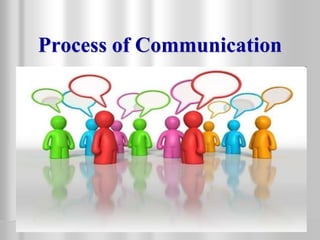
Revised Process of Communication
- 2. Stages of Communication Communication is a dynamic interactive process. It consists of five steps which are as follows: Ideation Encoding Transmission Decoding Response (Feedback)
- 3. Ideation Formation of idea or selection of a message to be communicated. Consists of “What” of communication------ content of the specific message. Scope of ideation------determined by the sender’s knowledge, experiences and abilities as well as the purpose of communication and the context.
- 4. ……Continued Types of Messages Logical -----Factual information Emotional------Feelings and emotions
- 5. Ideation in a Formal Communicative Situation Finding and selecting a subject or general topic Looking for ideas and thoughts Deciding the type and sources of information.
- 6. Encoding The process of changing the information into some form of logical and the coded message. In a formal situation, encoding involves: Selecting a language Selecting a medium of communication Selecting an appropriate communication form
- 7. Communication Forms Form Examples 1. Interpersonal face to face communication 2. Group Communication 3. Speaker-audience Communication 4. Telephonic Communication 5. Written Communication Casual conversations, formal interaction, interviews Meetings, conferences Speeches, seminars Personal interactions, business deals Reports, memos, proposals, letters, emails
- 8. Transmission Flow of message over the chosen channel One of the most basic aspects of communication-----involves choosing the proper time (When), proper place (Where) and a proper way (how).
- 9. Decoding The process of converting a message into thoughts by translating the received message into an interpreted meaning in order to understand the message communicated. Interpretation of the message. Oral communication----listening and understanding Written communication------ reading and understanding
- 10. Response The action or reaction of the receiver to the message. Feedback ------ acceptance or rejection Key to communication
- 11. The Communication Process Sender Receiver Sender has an idea Sender coverts the idea into words and gestures Message travels over channel Receiver decodes message Receiver responds Ideation Encoding Transmission Decoding Feedback
- 12. ……. Continued
- 13. Some Basic Truths about Communication Meanings sent are not always received No two minds have identical filters, storehouses of words, gestures, facial expressions They might not attach same meanings to all symbols
- 14. …………….Continued Meaning is in the mind Consider the communication abilities of the receivers Receivers do not look at the meaning alone; they also look for the intended meaning
- 15. ………………….Continued The symbols of communication are imperfect Words are crude substitutes for the real thing Man, dog, house and run etc. Communicators vary in their ability to communicate thoughts Lack of equivalent words in various cultures
- 16. Resulting stress on adaptation Adaptation of messages to the minds of receivers Adaptation ---- fitting the message to the recipients
- 17. Differences between Written and Oral Communication Written Communication--- usually involves creative effort Oral face to face communication---- communication cycles occur fast Written communication---- messages may communicate over extremely long time periods (e-mails and text messages are exceptions). Limited number of communication cycles in written communication
